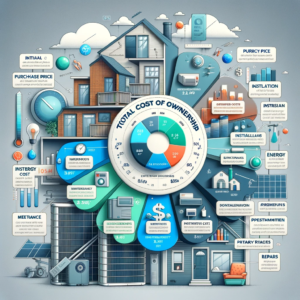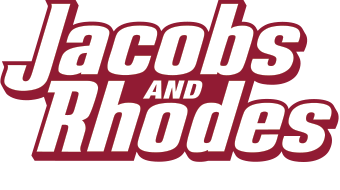Understanding the Total Cost of Ownership for HVAC Systems
 When considering the installation of an HVAC system, whether for your home or business, it’s essential to understand not just the benefits, but also the costs involved.
When considering the installation of an HVAC system, whether for your home or business, it’s essential to understand not just the benefits, but also the costs involved.
From initial costs and types of systems to ongoing maintenance and energy savings, we aim to provide a clear picture of what to expect financially.
As a trusted name in the HVAC industry, Jacobs and Rhodes is dedicated to helping customers make informed decisions that balance comfort, efficiency, and cost-effectiveness. Let’s explore the initial costs of investing in HVAC comfort, the nuances of maintenance and repair expenses, and the potential for long-term energy savings.
Initial Costs: Investing in HVAC Comfort
Cost can vary significantly based on the type of system, size of your space, and the specific needs of your property.
Generally, there are three main types of HVAC systems:
Split Systems
- Cost Range: Typically, the cost for a split system HVAC unit can range from approximately $9000 to $25,000 or more. This includes both the outdoor and indoor units.
- Factors Influencing Cost: The price varies depending on the capacity (measured in tons), efficiency (SEER rating for cooling and AFUE rating for heating), and the brand of the system. Higher efficiency units are more expensive but can lead to long-term energy savings.
Packaged Systems
- Cost Range: Packaged systems generally cost between $8000 and $20,000, including installation.
- Factors Influencing Cost: These systems are typically more expensive due to their compact design and the convenience of having all components in one unit. The cost may also vary depending on the system’s heating and cooling capacity and energy efficiency.
Ductless Mini-Split Systems
- Cost Range: For ductless mini-split systems, prices usually start around $3500 to $9000 per unit and can go up to $12000 or more for multi-zone systems.
- Factors Influencing Cost: The primary factors affecting cost are the number of indoor units (zones), total BTU (British Thermal Units) capacity, and the system’s SEER rating. Ductless systems with multiple zones and higher energy efficiency ratings are more expensive.
These costs generally include both the price of the units and the installation fees, but installation costs also vary depending on the complexity of the system and the structure of your home or business.
Additional factors like the need for any ductwork modifications (for split and packaged systems), electrical upgrades, or special installation circumstances can add to the overall cost. It’s always recommended to get a detailed quote from a reputable HVAC provider like Jacobs and Rhodes to understand the full cost implications for your specific situation and needs.
Ongoing Maintenance: The Key to Longevity
Regular maintenance is vital in ensuring your HVAC system operates efficiently and has a long lifespan. Neglecting maintenance can lead to decreased efficiency, higher utility bills, and more frequent repairs. Jacobs and Rhodes offer “Ted’s Comfort Club” a planned maintenance service tailored to your heating and cooling equipment needs.
A well-maintained system can last up to 15-20 years, while a neglected one might fail in just half that time.
The cost of regular maintenance will vary, but it’s a worthwhile investment to avoid more substantial costs down the line.
- Annual Service Contracts: Many HVAC companies offer annual service contracts or maintenance plans. These typically range from $150 to $500 per year. These plans often include a comprehensive check-up, cleaning, and tuning of your system.
- Filter Replacement: Air filters should be replaced every few months, and this is a task that many homeowners can do themselves. The cost of filters ranges from $10 to $150 each, depending on the type and quality.
- Duct Cleaning: If duct cleaning is required, this can be a more significant expense. Professional duct cleaning services can cost anywhere from $425 to $700, depending on the size of your system and the complexity of your ductwork.
Remember, these are generic estimates, and actual costs can vary. Regular maintenance not only keeps your system running efficiently but also helps in identifying potential problems early, thus avoiding more expensive repairs in the future.
Regular maintenance also helps put your system and equipment back to factory specifications.
It’s always a good idea to get a specific quote from a local HVAC service provider like Jacobs and Rhodes for the most accurate pricing in your area.
Repair Expenses: Planning for the Unexpected
No matter how well you maintain your system, repairs are sometimes inevitable due to normal wear and tear.
Common repairs include fixing refrigerant leaks, replacing thermostats, or repairing malfunctioning components. Costs can range from a few hundred to several thousand dollars, depending on the severity of the issue.
- One-Time Maintenance Visits: If you’re not on a service contract, a one-time maintenance visit can cost between $70 and $200. This usually includes basic services like cleaning the system, checking for issues, and making minor adjustments.
- Refrigerant Recharge: If your system needs a refrigerant recharge, this can cost between $350 and $1500, depending on the type of refrigerant and the amount needed.
To mitigate these expenses, consider a service agreement with a trusted company like Jacobs and Rhodes. Such agreements often include regular maintenance checks and can provide discounts on repairs.
Remember, these are generic estimates, and actual costs can vary.
Energy Savings: The Long-Term Benefit
One of the most significant long-term costs of an HVAC system is the energy it consumes. However, this is also an area where you can realize substantial savings.
Modern, energy-efficient systems can reduce your energy bills significantly, sometimes by as much as 20-40%. While these systems have a higher initial cost, the long-term savings can be considerable.
Factors influencing energy efficiency include the Seasonal Energy Efficiency Ratio (SEER) for cooling and the Annual Fuel Utilization Efficiency (AFUE) for heating. The higher these numbers, the more efficient the system. Additionally, smart thermostats and regular maintenance can also contribute to lowering energy costs.
Total Cost of Ownership: A Comprehensive View
To truly understand the total cost of ownership of an HVAC system, you need to consider all these factors. Here’s a simple breakdown:
- Initial Purchase and Installation: This is a one-time cost, but it’s a significant investment. Choosing the right system for your needs is crucial.
- Ongoing Maintenance: Regular maintenance costs are relatively low compared to repair or replacement costs and are essential for efficiency and longevity.
- Repair Expenses: These are unpredictable but planning with a service agreement can help manage them and possibly save you overtime fees.
- Energy Costs: This is an ongoing expense, but investing in an energy-efficient system can lead to significant savings.
It’s important to remember that the cheapest option isn’t always the most cost-effective in the long run. Investing in a quality system and regular maintenance can save you money and provide comfort for years to come.
Conclusion
The journey of owning an HVAC system encompasses more than just the initial purchase and installation costs. It’s a continuous process that involves regular maintenance, readiness for repairs, and an eye on energy consumption.
By understanding the total cost of ownership, from the initial investment in different types of systems like split, packaged, or ductless mini-split systems, to the ongoing expenses of maintenance and energy bills, homeowners and businesses can make more informed choices.
Jacobs and Rhodes stand ready to assist in navigating these decisions, offering expertise, financing and tailored solutions that align with your specific needs and budget.
Remember, investing wisely in your HVAC system not only ensures a comfortable environment but also contributes to long-term financial and energy efficiency. With careful consideration and professional guidance, you can achieve a balance of comfort, cost, and efficiency in your HVAC system.
Contents

 Jacobs and Rhodes
Jacobs and Rhodes